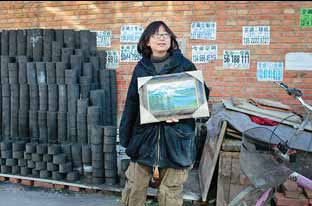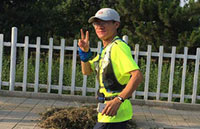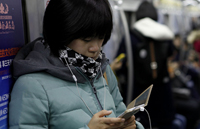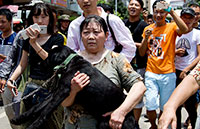Painting a grim picture in Songzhuang
By Zhao Xu (China Daily) Updated: 2012-11-22 08:53On average, 1,500 artists have come and gone in each of the past three years. Of the 5,000 currently living in the community, only 10 percent to 15 percent are capable of making ends meet solely through the sale of their artworks. The rest rely on handouts from their families or resort to part-time jobs, from painting T-shirts to delivering the mail.
 |
|
Xu Lili displays her oil paintings outside the room she rents in the village. |
"With no need to worry about living costs, I'll no longer be under pressure to cater to clients when making real art," said Dou, referring to his primitive-looking sculptures, which are striking but hardly eye candy.
Poverty vs faith
Dou's view was echoed by many of those in Songzhuang, who believe that the question of living has to be resolved before that of art. However, that opinion is likely to meet vehement opposition from Hu Yuepeng, a long time local presence whose tireless documentation of the area - his words filled with pungent criticism and cool wit - has won a loyal following among many local artists.
"Contemporary art is all about attitude. A person only qualifies as a contemporary artist as long as he or she upholds the vision of being totally independent and never bending to market forces," said Hu. "Poverty does not necessarily make one a true artist - faith does. The only thing that can pull a struggling artist out of the morass is his self belief."
But what if the artist is cold and hungry?
"A true artist keeps others moved and inspired by his uncompromising spirit. In return, he receives help from others in times of need," said the critic, who has been a major force behind a campaign to raise funds for a local artist with severe kidney disease.
Although Hu's views may sound idealistic or even puritanical, they point to an important aspect of Songzhuang culture - the brotherhood of artists - which many residents lament hardly exists nowadays. Many yearn for a return to the days when everyone knew everyone else and the sale of a painting would usually result in large meal for the painter and his rejoicing artist friends.
That "warm and fuzzy" era has gone forever, according to Li Guangming, curator of Songzhuang's Sunshine International Art Museum.
"Imagine when a bunch of artists first came to this strange rural place, 24 km from the center of Beijing. They had no one to turn to but each other," he said. "Now we have this two-tier structure with a couple of dozen sitting on top and the rest languishing far below. And if you talk about rich artists helping out poor ones, the immediate question is: which?"
Looking back, Li reckoned that the promise of Songzhuang has always existed, although it means different things to different people.
"The meteoric rise of the few auction-record-breaking Songzhuang artists, such as Yue Minjun and Zhang Xiaogang, between 2004 and 2007 filled many with illusions," he said. "In reality, they (the successes) are and will remain the exceptions. The experimental nature of contemporary art means that its practitioners will have to remain on the fringes.
"From a historic and artistic perspective, the dilemma of Songzhuang is the dilemma of contemporary Chinese art. After 30 years of development inspired by art schools and ideas from the West, it has come to a grinding halt," he said. "There's no way forward without an injection of real creativity."
The curator had some words of warning for aspiring artists heading in his direction: "Think about what you are after. If it's passion, you can find it in your own heart; if it's money, think twice!"
Contact the author at zhaoxu@chinadaily.com.cn
- Li vows to boost support for real economy
- 2020 health plan to ease burden on people in poverty
- US urged not to rock the boat by flexing its muscles
- Thousands flee their homes amid fatal downpours
- Chinese supercomputer tops list of world's fastest
- Booze banned at official banquets
- Students paying $15,000 to consultants to select college
- US urged not to meddle with internal Tibet affairs
- China puts squeeze on imported TV shows and remakes
- Apple's appeal in iPhone case accepted by IP court








